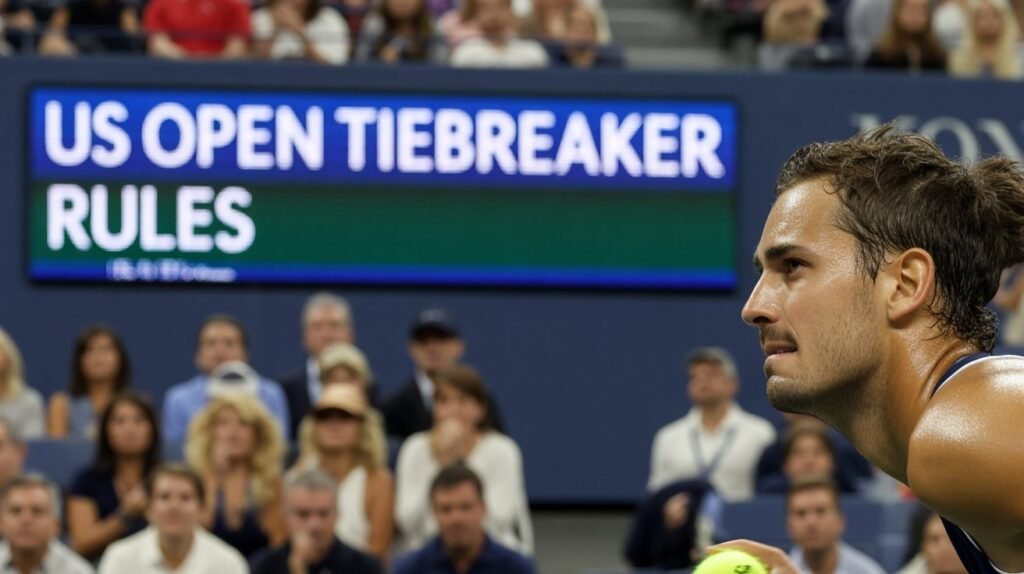US Open Tiebreaker Rules: A Simple Guide to the Drama Behind the Final Sets

Introduction
In the world of tennis, few tournaments are as exciting, intense, and unpredictable as the US Open. It’s one of the sport’s four Grand Slam events and is known for late-night matches, roaring crowds, and edge-of-your-seat moments. But one of the biggest questions casual tennis fans often ask is: What happens when players are tied? How do they break the tie? This is where the US Open tiebreaker rules come in.
These rules decide who wins and who goes home after grueling sets and long rallies. And over the years, the tiebreaker rules at the US Open have changed, improved, and stirred up emotion—just like the matches themselves.
In this friendly, easy-to-understand guide, we’ll explore everything you need to know about the US Open tiebreaker rules. We’ll cover how they work, when they apply, and why they matter. Whether you’re new to tennis or just curious, we’ll keep things simple so you can follow all the action without missing a beat.
What Is a Tiebreaker in Tennis?
Before we dive into US Open tiebreaker rules, let’s explain what a tiebreaker actually is. In tennis, matches are divided into sets. To win a set, a player must win at least six games and be ahead by two games.
But sometimes, players are both tied at 6–6. They each keep winning games, until the score becomes stuck. That’s when a tiebreaker is used to decide who gets the set.
A tiebreak is a fast-paced extra game where players score points instead of traditional games. It’s usually the first to 7 points, with a margin of two. If it’s tied 6–6 in the tiebreak, they keep going until someone wins by two points.
Tiebreakers are important because they prevent sets from going on forever—and they add a lot of suspense!
US Open Tiebreaker Rules: The Basics
Now, let’s focus on the US Open tiebreaker rules. These rules have been part of the tournament for many years and are known for being a bit different from the other Grand Slam events.
Here are the basics:
- The US Open uses a tiebreaker at 6–6 in every set, including the final set (third set in women’s matches, fifth set in men’s).
- This makes the US Open unique because other Grand Slam events used to require a player to win by two full games, especially in the final set.
- The US Open led the way in introducing final-set tiebreakers to make matches more predictable for players, fans, and broadcasters.
This rule has helped cut down on ultra-long matches and made sure champions are crowned at a practical time.
History of US Open Tiebreaker Rules
The US Open tiebreaker rules actually made tennis history. The US Open was the first Grand Slam to introduce a final-set tiebreak, all the way back in 1970.
Before that, long matches could go on for hours (even days!), especially if neither player could pull ahead by two games. That made things tough not just physically, but also for scheduling.
In 1970, the US Open introduced the 12-point tiebreaker system created by James Van Alen. It was a bold move, and it forever changed tennis. The idea was simple: make matches fairer and shorter, without losing the thrill.
So when you see a match ending in a tiebreaker, remember—it all started at the U.S. Open.
What Makes US Open Tiebreaker Rules Different from Other Majors?
For many years, the US Open stood out for its final-set tiebreaker. Other Grand Slams like Wimbledon and the Australian Open didn’t follow this rule until much later.
Here’s a quick comparison:
- Australian Open: Uses a 10-point tiebreak at 6–6 in the final set.
- French Open: Joined late in using final-set tiebreaks. Now uses a 10-point breaker as well.
- Wimbledon: Uses a 10-point tiebreak at 12–12 in the final set.
- US Open: Always used a standard 7-point tiebreak at 6–6 in every set, even the final.
That means the US Open tiebreaker rules are shorter and faster, making sudden-death action more likely and more exciting.
Explaining the 7-Point Tiebreaker in the US Open
Let’s break down exactly how the 7-point tiebreaker works in the US Open tiebreaker rules:
- The first server serves one point from the right side of the court.
- After that, players alternate two serves each (starting from the left side).
- The players switch ends of the court every six points.
- The first player to reach 7 points wins the tiebreaker—but they must win by at least two points.
- If the score reaches 6–6, they continue until one player wins by two.
This format keeps things fast and filled with tension. A single mistake can turn the tide, making it a nerve-wracking experience for pros and fans alike.
Why Tiebreaker Rules Matter for Players
The US Open tiebreaker rules make a big difference in how players prepare and think. In long tournaments with multiple matches, it’s important to save energy.
In events like Wimbledon (before updating its format), players might compete for hours in extended final sets. This led to tired arms, sore legs, and marathon matches that could harm their next-round chances.
With the US Open’s final set tiebreaker, players can finish matches sooner and recover faster. They also know exactly what’s coming if things are tied at 6–6.
This allows for smarter game planning and less physical strain during one of the toughest competitions in tennis.
Famous Matches Affected by US Open Tiebreaker Rules

Some of tennis’s most unforgettable moments happened during matches decided by the US Open tiebreaker rules.
- In 1980, John McEnroe beat Björn Borg in a nail-biting fourth-set tiebreak (18–16!) during their semi-final.
- Pete Sampras vs. Andre Agassi in the 2001 quarterfinal was another case where tiebreakers decided three of the four sets!
- In 2012, Andy Murray beat Novak Djokovic in five sets to win the US Open, with tiebreakers helping him capture early momentum.
These matches show how tiebreakers add drama and highlight clutch performances. They’re great for viewers and test the mental strength of every player.
How US Open Tiebreaker Rules Affect TV and Fans
The US Open tiebreaker rules don’t just help players—they’re a big help to broadcasters and fans too.
Imagine you’re watching at home or attending a night match. A match without tiebreakers could stretch for hours, often past midnight. It’s hard to make plans or even stay awake for some of it.
With tiebreakers in every set, fans and TV networks can expect roughly predictable match lengths, even if it’s close. This helps with scheduling and keeps excitement high, especially in primetime viewing hours.
Plus, tiebreakers are thrilling! Every point matters and fans sit on the edge of their seats until the final hit.
Common Confusion About the Final Set Rule
One area that still causes confusion is the final-set tiebreaker. While all sets at the US Open go to a tiebreak at 6–6, fans often mix up the rules since other tournaments had different styles.
So, here’s the simple rule:
At the US Open, the final set uses the same tiebreaker as all earlier sets—7-point system at 6–6.
There’s no switch to a longer 10-point system or a 12–12 rule like at other Grand Slams. This makes it easier to understand and quicker to finish.
Knowing this difference helps fans follow the action without wondering what’s coming next.
Impact of US Open Tiebreaker Rules on Younger Players
For newer or younger tennis players coming into the game, the US Open tiebreaker rules provide relief and guidance. They know exactly what to expect—in every round—if a set is tied.
That makes training easier. It also gives junior and college players the chance to study pro matches and plan for similar scenarios in their own games. They can practice 7-point breakers specifically, which helps them feel confident in clutch moments.
It also shows them that tennis doesn’t have to rely on ultra-long sets to be fun or meaningful. A well-timed tiebreaker can still show who has the heart of a champion.
FAQs
1. What is the US Open tiebreaker rule?
At the US Open, if a set reaches 6–6, a 7-point tiebreaker is played. This applies to all sets, including the final set.
2. Does the US Open use a tiebreaker in the fifth set?
Yes. The US Open is the only Grand Slam that has long used a standard tiebreaker in the fifth set.
3. Are there other types of tiebreakers in tennis?
Yes. Some tournaments use a 10-point tiebreaker in the final set, while others used to play without tiebreaks at all.
4. What happens if the tiebreak is tied 6–6?
Players continue until one player leads by two points, such as 8–6, 9–7, or 10–8.
5. When did the US Open first use tiebreakers?
The US Open introduced tiebreakers in 1970, making it the first Grand Slam to do so.
6. Why are tiebreakers good for tennis?
Tiebreakers keep matches fair and quick while still keeping them exciting. They reduce physical strain on players and help fans enjoy the action more.
Conclusion
The US Open tiebreaker rules are a great example of how smart rules make sports better. They help players bring out their best when it matters most. They bring fans close to the action, turning every point into a must-watch moment.
By keeping the matches tight and predictable, the US Open creates suspense that works for everyone—players, fans, organizers, and even TV networks. And by staying true to the 7-point tiebreak from the very beginning, the US Open earned its place as a trendsetter in tennis that others eventually followed.
Next time you watch a late-night tennis battle at the US Open, you’ll know exactly what’s at stake—and how just a couple of points can make history.
So grab some popcorn, pick your favorite player, and enjoy every nerve-racking moment. Because nothing in tennis is quite like an US Open tiebreaker.





